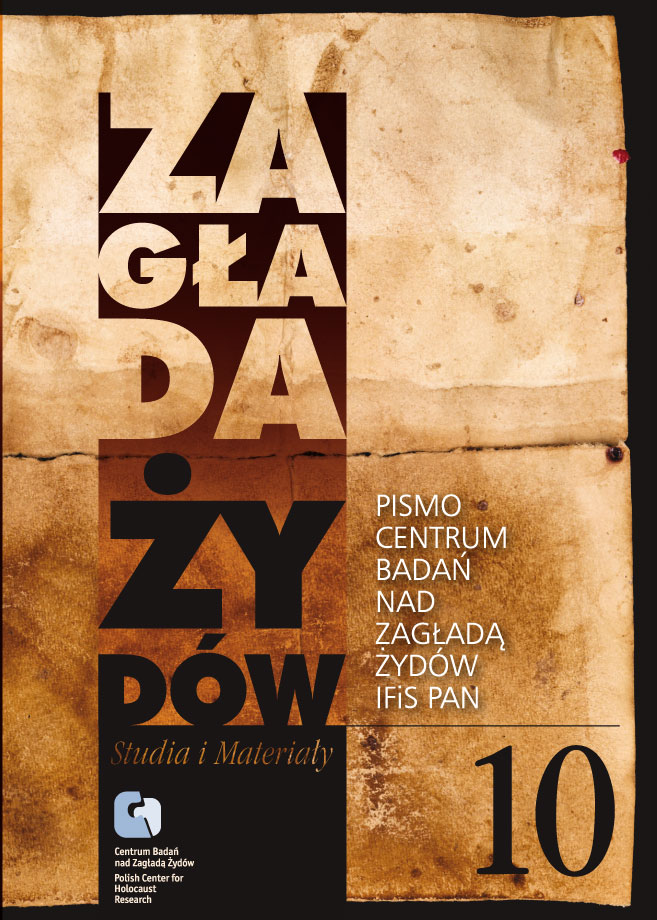Krzesiny i Kreising – między pamiętaniem a pomijaniem. Polskie miasteczko wobec historii, pamięci i rywalizacji w cierpieniu
Zagłada Żydów. Studia i Materiały, Nr 10 (2014), Strony: 443-461
Data zgłoszenia: 2020-10-22Data publikacji: 2014-12-01
 https://doi.org/10.32927/ZZSiM.532
https://doi.org/10.32927/ZZSiM.532
Abstrakt
The area around Krzesiny, located near the city of Poznań, Poland, witnessed several dark events during World War II: Germans oppressed the local population, culminating in a terrorizing action dubbed “akcja krzesińska;” also, a forced labor camp, named “Kreising,” was built near the township, housing mainly Jews. After the war, the suffering in Krzesiny was remembered, but selectively – “akcja” and other forms of Polish suffering were commemorated, while the camp was not. By exploring the “lieux de mémoire” in Krzesiny – dynamics of memory in a small township in Poland – this paper uses localized research to address the issue of gaps in collective memory and commemoration. We briefly look at the relevant history, Polish memory regarding wartime events in Krzesiny, and the postwar dynamics of collective memory. Discussing the latter, we identify a new phenomenon at work, one which we dub “collective disregard” – group neglect of the past of the “Other” that occurs without clear intent. We argue that “collective disregard” is an issue that naturally occurs in the dynamics of memory. By making a deliberate investment in balanced remembrance and commemoration, societies can counter the tendencies of “disregard” and curb the controversies of competitive victimization claims, also called “competitive martyrdom”.
Licencja
Prawa autorskie (c) 2014 Autor & "Zagłada Żydów. Studia i Materiały"

Utwór dostępny jest na licencji Creative Commons Uznanie autorstwa 4.0 Międzynarodowe.
https://creativecommons.org/licenses/by/4.0
Podobne artykuły
- Agnieszka Haska, „Na tej fabryce nie pracują Żydzi”. Nieznana historia pomocy , Zagłada Żydów. Studia i Materiały: Nr 19 (2023)
- Dariusz Libionka, Against a Brick Wall. Interventions of Kazimierz Papee, the Polish Ambassador at the Holy See with Regard to German Crimes in Poland, November 1942–January 1943 , Zagłada Żydów. Studia i Materiały: 2008: Holocaust Studies and Materials
- Marta Janczewska, Research on Starvation in the Warsaw Ghetto – Ethical Problems , Zagłada Żydów. Studia i Materiały: 2010: Holocaust Studies and Materials
- Dariusz Libionka, Głową w mur. Interwencje Kazimierza Papée, polskiego ambasadora przy Stolicy Apostolskiej, w sprawie zbrodni niemieckich w Polsce, listopad 1942 – styczeń 1943 , Zagłada Żydów. Studia i Materiały: Nr 2 (2006)
- Aleksandra Ubertowska, Berel Lang, Nazistowskie ludobójstwo. Akt i idea , Zagłada Żydów. Studia i Materiały: Nr 3 (2007)
- Sławomir Buryła, Nechama Tec, Daniel w jaskini lwa. Życie Oswalda Rufeisena , Zagłada Żydów. Studia i Materiały: Nr 5 (2009)
- Aleksandra Mialik, Katarzyna Liszka, Etyka i pamięć o Zagładzie , Zagłada Żydów. Studia i Materiały: Nr 13 (2017)
- Tadeusz Epsztein, Wspomnienie o dr Rucie Sakowskiej (1922–2011) , Zagłada Żydów. Studia i Materiały: Nr 10 (2014)
- Laurence Weinbaum, Epizod z biografii Dawida Wdowińskiego , Zagłada Żydów. Studia i Materiały: Nr 9 (2013)
- Marian Turski, Przemowa ocalałego z getta łódzkiego wygłoszona 29 sierpnia 2019 r., w dniu obchodów 75. rocznicy likwidacji getta łódzkiego , Zagłada Żydów. Studia i Materiały: Nr 16 (2020)
<< < 1 2 3 4 5 6 7 8 9 10 11 12 13 14 15 16 17 18 19 20 21 22 23 24 25 26 27 28 29 30 31 32 > >>
Możesz również Rozpocznij zaawansowane wyszukiwanie podobieństw dla tego artykułu.
 English
English
 Język Polski
Język Polski








